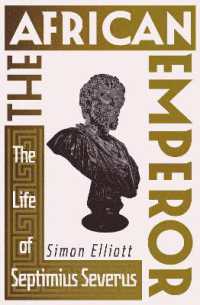- ホーム
- > 洋書
- > 英文書
- > Nature / Ecology
Full Description
Based on several years of ethnographic fieldwork, the book explores life in and around a Luo-speaking village in western Kenya during a time of death. The epidemic of HIV/AIDS affects every aspect of sociality and pervades villagers' debates about the past, the future and the ethics of everyday life. Central to such debates is a discussion of touch in the broad sense of concrete, material contact between persons. In mundane practices and in ritual acts, touch is considered to be key to the creation of bodily life as well as social continuity. Underlying the significance of material contact is its connection with growth - of persons and groups, animals, plants and the land - and the forward movement of life more generally. Under the pressure of illness and death, economic hardship and land scarcity, as well as bitter struggles about the relevance and application of Christianity and 'Luo tradition' in daily life, people find it difficult to agree about the role of touch in engendering growth, or indeed about the aims of growth itself.
Contents
Table of illustrations
Acknowledgements
Chapter 1. Introduction: "Are we still together here?"
A community at the end of the world
The death of today
Growing relations
Being together
Growth
Touch
Searching for another social practice
Engaging boundaries
Hygiene
Knowing boundaries
Changing perspectives?
Coming together
Visiting
Chapter 2. Landscapes and histories
Returns
A road in time
Kisumu
Driving out Bondo District
The lake
Piny Luo - 'Luoland'
A 'tribe'
Luo sociality
The reserve
Return to Uhero Yimbo Muthurwa
Making Uhero village
(Re-)Settlement
Belonging and ownership
A modern Luo village
'Down' into the village
'Up' and 'down' KaOkoth
Alternative 'modernities': the beach and 'Jerusalem'
KaOgumba
Chapter 3. Salvation and Tradition: heaven and earth?
Dichotomies in everyday life
Salvation
Strong Christians
Saved life
Saved and others
Faith in purity
Tradition
The Luo rules
'Born-again'
Traditionalism
Traditionalism, Christianity and The West
Customary everyday life
Searching ways
Tradition in everyday life
Everyday ritual
The absence of ritual
The omnipresence of ritual
PART ONE
Chapter 4. 'Opening the way': being at home in Uhero
Introduction
"Our culture says that one must make a home"
Relational flows: embedding growth in the home
Tom's new home
Moving forward - directions
Openings and closures
Order and sequence
Complementarity and growth: coming together in the house
Making a house
Sharing the gendered house
The living house
Gender, generation and growth
Struggling against implication
The home in heaven
'The rules of the home'
Powers of explication
Practicing rules
Cementing relations
Traditionalism and other kinds of ethnography
5. Growing children: shared persons and permeable bodies
Introduction
Sharing
Sharing or exchange?
Sharing food
Food, blood and kinship
'The child is of the mother'
Changed foods and relations
Sharing and dividing nurture
Shared bodies
Illnesses of infancy and their treatment
Evil eye and spirits
Medical pluralism?
Herbal medicines
Cleanness and dirt
Sharing names
Being named after
Being called
Sharing names and naming shares
Conclusion
PART TWO
Chapter 6. Order and decomposition: touch around sickness and death
Introduction
Otoyo's home
The sickness of a daughter
Return of a daughter
Kwer and chira
Continuity and contingency
Avoiding the rules
Treating chira
Caring
The death of a husband
Expected death
"She should remember her love!"
Death
The funeral
The dead body
Loving people
Conclusion
Chapter 7. 'Life Seen': touch, vision and speech in the making of sex in Uhero
Introduction
Earthly ethics and Christian morality
Riwruok
Riwruok: outside intentionality
Chira: Growth and directionality
Chodo and luor: continuity and change
Cleanness: Sex and separation
The proliferation of 'Sex'
AIDS and chira
The fight against AIDS
Pornography - 'bad things'
Conclusion
Chapter 8. "Our Luo culture is sick": identity and infection in the debate about widow inheritance
Introduction
Testing positive
Becoming a widow
Contentious practices
A tough head
Tero
Independence
Alone
Inheritance and infection
Past and present tero
Fighting tero
Deprivation and property
Inheriting HIV - fears about women's sexuality and social reproduction
Turning tero into a business
Ambiguous heritage: Tero as source of identity and infection
'Our Luo culture is sick'
'The most elaborate and solemn ritual': tero is our culture
Sanitising Luo culture?
Conclusion
PART THREE
Chapter 9. "How can we drink his tea without killing a bull?" - funerary ceremony and matters of remembrance
Introduction
Funerary ceremonies
Funerals in Uhero
Funeral commensality
Returning to the funeral
Osure's sawo
An Earthly feast
Rebekka
Eating the sawo
Traces of the past
'Sides'
Baba Winston's memorial
A Christian funerary celebration
Debates
The service
Remembrance
Conclusion
Chapter 10. "The land is dying" - Traces and monuments in the village landscape
Introduction
Cutting the land
Ownership
Land, paper and power
Living on the land
Gardens and farms
The bush
Fences
At home
Traces and inscriptions
Getting one's land - finding one's place
Conclusion
Chapter 11. Contingency, creativity and difference in western Kenya
Creative difference
Old and new dealings with hybridity
"Are we still together here?"
Postscript
Ka-Ogumba 2007
Bibliography
Books and Articles
Newspaper articles and electronic media
Music
Index








